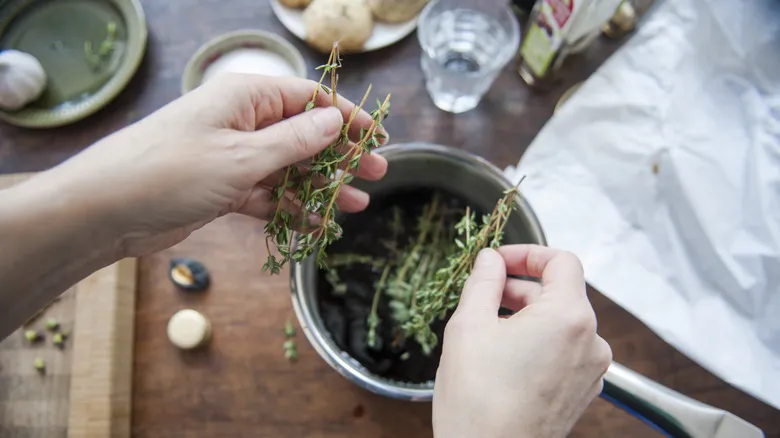What its thyme?
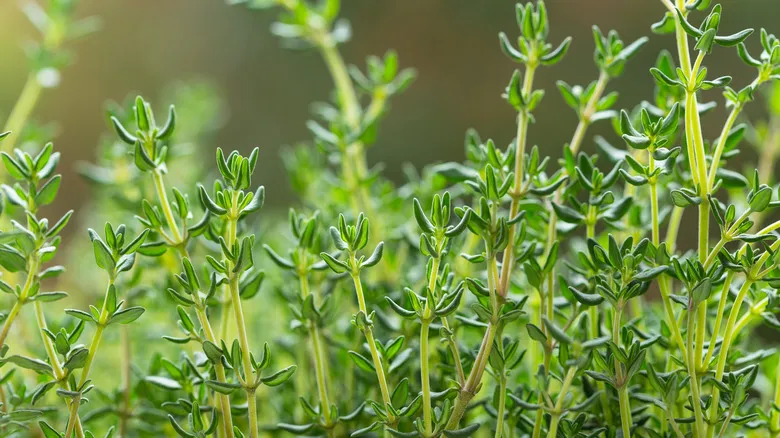
Thyme, also known as common thyme (Thymus vulgaris), is a hardy perennial herb that is simple to cultivate and even easier to incorporate into culinary dishes. It features small, aromatic leaves on long, branching stems that can be harvested throughout the year. As an evergreen, it typically reaches heights and widths of 6 to 12 inches, although a wide range of thyme varieties provides home gardeners with numerous choices. Nevertheless, common thyme remains the most favored variety in gardens (no pun intended).
The distinctive fragrance of thyme is attributed to thymol, the primary compound responsible for the strength of its essential oil and its minty scent, which indicates its classification within the Lamiaceae family, commonly known as the mint family. This compound is also prominent in the production of liqueurs, perfumes, and various traditional dishes. Thyme's close relatives include oregano, basil, lavender, rosemary, and, of course, mint itself.
A brief history of thyme

Thyme has been a part of human history for millennia. The wild variety still thrives in the region of Eurasia known as the Levant, which encompasses Turkey, Jordan, Lebanon, Syria, and Israel/Palestine, suggesting that this may be its origin.
By the time of ancient civilizations, thyme was abundant around the Mediterranean and Near East. The Egyptians utilized it as an embalming substance, while the Greeks employed it for incense and aromatic baths. The resourceful and diverse Romans likely played a key role in disseminating thyme throughout what would later become Medieval and modern Europe.
The contemporary name derives from the Greek term "thymos," which translates to courage or strength and was used to describe plants in the Thymus or Satureja genera. With thousands of years of cultivation across the globe, it’s no wonder that thyme is now available in over 50 varieties. Thyme was introduced to the Americas by the first European settlers, who valued it as both a culinary and medicinal herb.
What does thyme taste like?
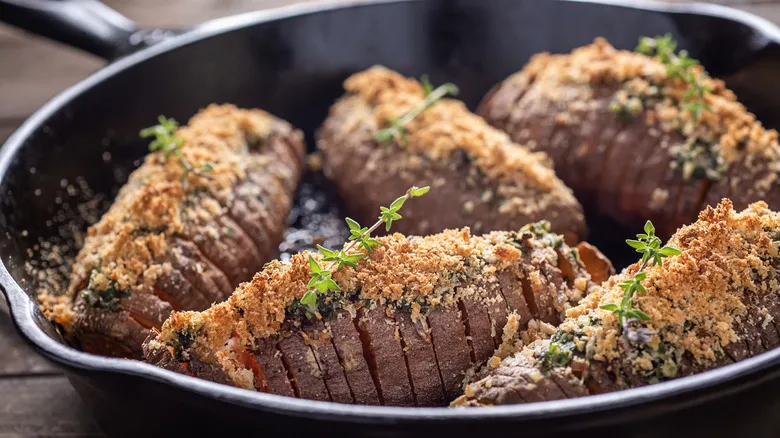
The initial response to this inquiry is another question: How does thyme smell? The scent of food significantly impacts its flavor, as our sense of smell allows us to experience a vast array of tastes beyond the five basic ones: sweet, salty, bitter, sour, and umami. It is the aroma that completes the sensory experience, manifesting in countless detectable variations in the human nose.
Thyme possesses a robust yet gentle herbal fragrance, shaped by its specific variety (such as lemon thyme or caraway thyme), whether it is fresh or dried, and other influencing factors, all of which contribute to its taste. Generally, thyme is characterized by a minty and fresh aroma, with earthy and slightly citrus notes. It is also noted for its clove-like, spicy, and savory qualities, often carrying floral undertones reminiscent of lavender and rosemary. Its subtle profile makes it an ideal partner for rich meats with creamy sauces, refreshing soups, and vibrant summer beverages, enhancing these dishes without overpowering them.
Fresh versus dried thyme
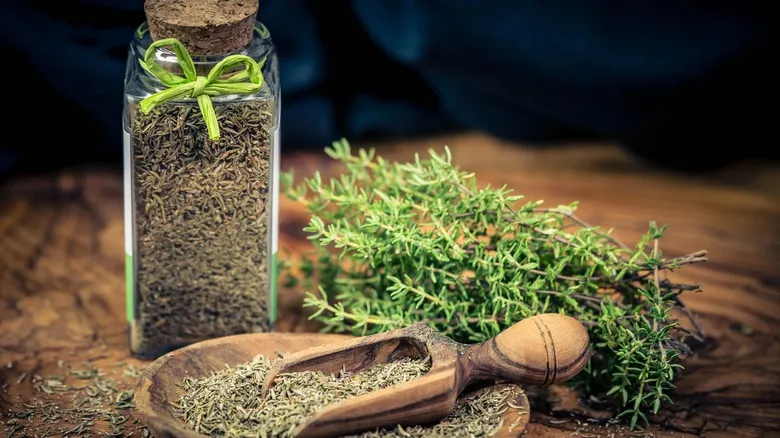
Fresh and dried thyme provide such distinct advantages that they could almost be considered two separate herbs. Generally, fresh herbs are more delicate and have a milder flavor. This is due to the fact that the aromatic compounds in dried herbs are non-volatile, meaning they do not evaporate when heated, unlike their fresh counterparts. Consequently, because dried herbs have a more concentrated flavor, you only need about one-third of the quantity compared to fresh.
The same holds true for thyme, regardless of the variety. While both fresh and dried thyme share the general characteristics mentioned, there are notable differences between them. Fresh thyme has a mild, sweet, and subtly earthy aroma and flavor. In contrast, dried thyme leans towards a more pronounced earthiness, accompanied by a less intense, peppery taste. However, it’s important to note that all dried herbs lose their potency over time. If you encounter dried thyme that lacks aroma, it’s not a reflection of the herb's quality, but rather an indication that it is simply too old.
Available forms of thyme
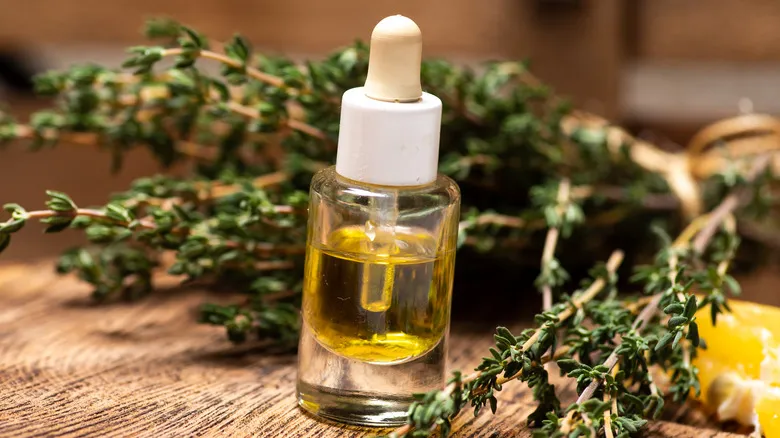
Thyme, much like other herbs from the Mediterranean region, is incredibly versatile and readily accessible. There are numerous varieties of thyme to choose from, including lemon, caraway, lavender, and juniper, among others. You can find the broadest selection at a nursery or online, while grocery stores typically carry common varieties, such as English or lemon thyme. Depending on your requirements, both fresh and dried thyme are available at most stores.
Essential oils offer another method to enjoy the aroma and flavor of thyme, but caution is necessary due to their high concentration. In culinary applications, just one drop of essential oil is equivalent to 2 teaspoons of dried thyme, so it's best to start with a small amount and adjust as needed. Generally, you'll need to visit a specialty shop or herbalist to find quality essential oils, although some co-ops and health food stores may stock them. For cooking purposes, it's preferable to use the leaves instead of the oil, as it allows for better control over the flavor.
How to choose the best herbs
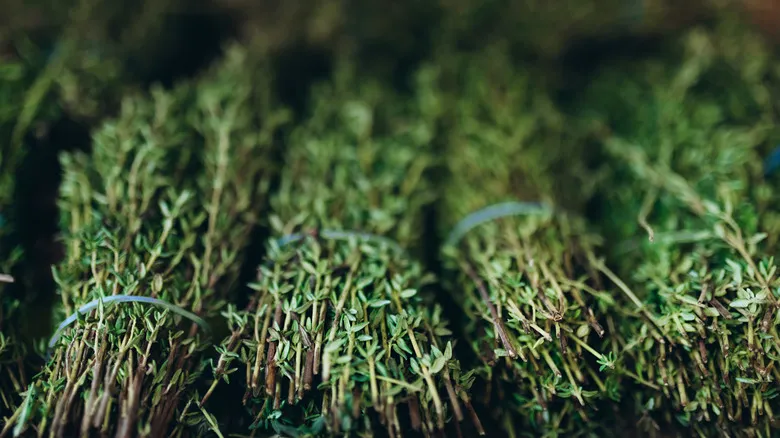
Selecting herbs isn't overly complicated, but if you're looking to enhance your cooking skills, it's beneficial to know what to seek out. The guidelines differ for fresh and dried herbs, and a few pointers can help you avoid bringing home bland or quickly spoiling seasonings.
When it comes to dried thyme, check the herbs section for leaves that are still vibrant green (not dull gray) and within their expiration date. Local herb vendors often provide fresher options that have been dried more recently and tend to have superior flavor. However, they may be pricier than larger brands, so it ultimately depends on your preference.
For fresh thyme, visit the produce aisle, where it’s displayed alongside other fresh herbs like rosemary, sage, parsley, and cilantro. When selecting fresh herbs, opt for bright green stems with healthy leaves and flexible, not brittle, stems. If you're pressed for time and can't make it to the store, you can also purchase fresh bundles of leaves online.
Pulling thyme: a necessary skill
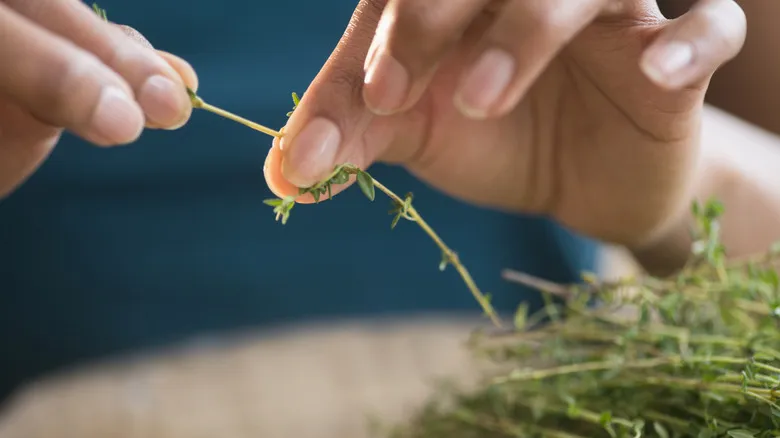
Many herbs are quite simple to work with, such as basil, cilantro, or parsley. However, thyme can be a bit trickier. If you’re unsure how to properly select it, fresh thyme can quickly become a frustrating challenge. Additionally, if not prepared correctly, you might end up with tough, woody bits in your soups and sauces, which is far from ideal.
To prevent this, start with fresh, washed sprigs of thyme, whether from your garden or the store. Begin by removing any flowers or dead parts, leaving you with vibrant green leaves. Then, pinch off the small bunch at the top of each stem for use. After that, flip the stem and gently run your fingers down the branch to detach the leaves. Interestingly, opting for thicker stems can make it easier to remove the leaves without damaging the stem.
If you prefer not to deal with leaf removal and are preparing a cooked dish like soup or braised meat, you can simply add the whole sprigs to the pot. Just remember to take them out before serving, as the woody stems are not meant to be eaten.
Using thyme in the kitchen
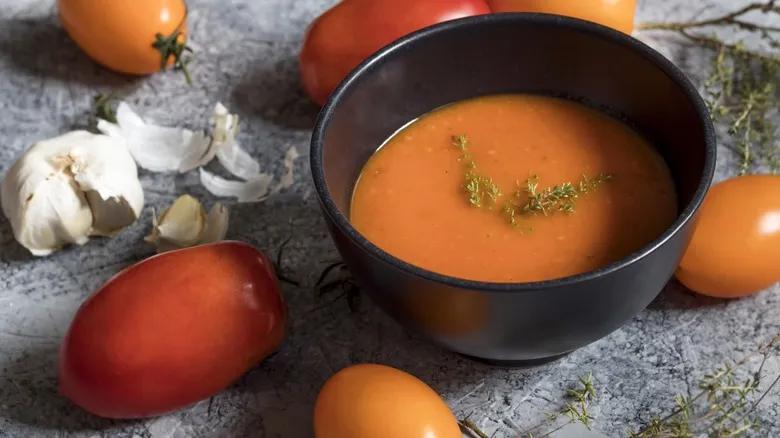
Thyme is incredibly flavorful, making it a versatile herb in nearly every culinary tradition. It's frequently found in Indian curries, African stews, Italian pasta dishes, and various other cuisines. You can use it to add a refreshing, herbal kick to soups, stews, salads, dips, potatoes, braised and roasted meats, risottos, roasted vegetables, and much more. From tomato tarts to red wine-braised short ribs, chicken pot pie to a fragrant herbed loaf of bread, it’s your secret weapon for savory dishes.
Additionally, thyme is a fantastic hidden gem for roasted potatoes. Honestly, I wouldn’t consider roasting a batch of potatoes without a dash of salt, garlic powder, and either fresh or dried thyme. Just chop the potatoes into 1-inch cubes, generously coat them with olive oil and seasonings, and bake at 425°F in a glass dish, uncovered, until they turn crispy.
Flavoring desserts with thyme

Thyme isn't limited to savory dishes. For example, you might be surprised to learn that a strawberry pavlova can be enhanced with a touch of Thymus vulgaris. This light and airy dessert demonstrates that thyme is versatile, blending beautifully with whipped cream, meringue, chopped fruit, and a refreshing, spicy kick from your new favorite herb.
Thanks to its delicate and floral taste when fresh, thyme can also be incorporated into jams, lemon bars, and even cakes. The key is to use very fresh thyme, ensuring all the stems are removed, so you capture that light herbal essence instead of the more intense sweetness of dried thyme. When creating a thyme-infused dessert, it's always a lovely touch to garnish with fresh sprigs.
It's cocktail thyme!

At last, the moment we've all been anticipating: how to incorporate thyme into your cocktail hour. There are numerous methods to achieve this. You could infuse your spirits with thyme for a few days, create a simple syrup to mix with your favorite liquor, or use fresh leaves and sprigs as a garnish. Thyme can also be utilized to craft mocktails or refreshing sparkling beverages for summer gatherings.
No matter what you choose, it's essential to use fresh herbs, as they enhance the quality of your drinks. This holds true for herb-infused lemonade just as much as for sparkling lemon-thyme cocktails or thyme-infused bourbon. But don’t feel overwhelmed; there’s plenty of time to try all three. For the lemonade, simply gather some fresh herbs and brew them with your lemonade, either by adding the simple syrup or by mixing in the fresh herbs at the end. (Herbs can also be fun to include in ice rings!)
If you’re leaning towards alcoholic beverages, consider a mix of thyme-infused vodka, lemon juice, plain simple syrup, rhubarb bitters, prosecco, and an ice cube in a shaker. Shake it all together and pour it into a glass. And remember, if you're using fresh herbs, give them a little slap first—this is a technique used by mixologists to release their flavors.
Substitutes for thyme
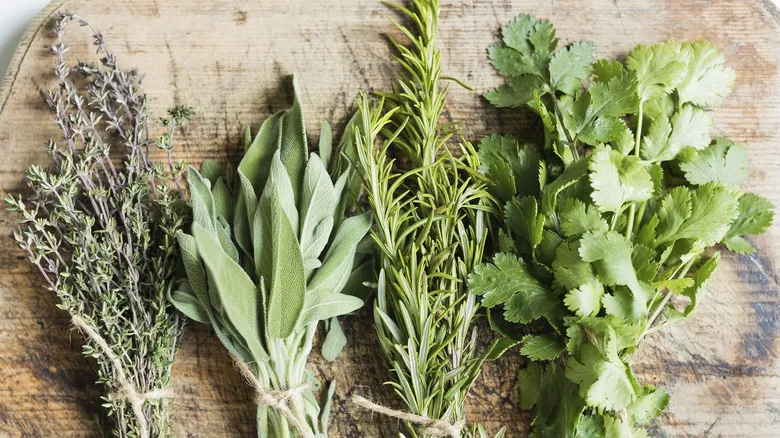
Don't have thyme available? No worries; several other herbs can easily fill in. The best alternatives are those with a similar minty, Mediterranean flavor profile. Consider using oregano, sage, marjoram, tarragon, or rosemary. Basil also shares a fragrant quality with thyme, which is why they are both included in Italian seasoning, making it a suitable substitute for either.
Other herbal blends like Za'atar or Herbs de Provence, which both contain thyme, come from Middle Eastern and French culinary traditions, respectively. You can even purchase a bouquet garni online, available as a loose-leaf mix or tied into bundles with string (similar to the smudging sticks found in many hippie homes). While traditionally made fresh, a classic bouquet garni typically includes parsley, bay, and thyme, so a dried version will work well if you're simmering your dish for an extended period. In a pinch, poultry seasoning can also be a good option.
Growing thyme at home
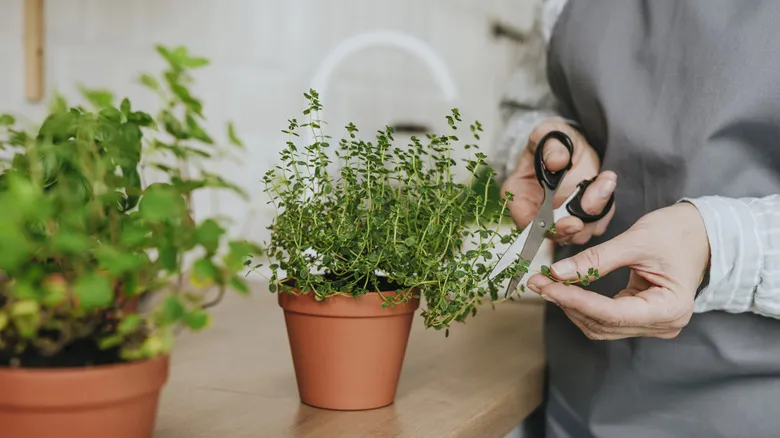
As mentioned, thyme is truly a resilient plant. It thrives in poor soil, requires minimal water and care, withstands intense sunlight, endures winter frosts, tolerates air pollution, and even deters deer. You could stomp on it daily, and it would remain unfazed—making it a gardener's ideal companion. Thyme grows most densely and blooms best in full sunlight, but it can also adapt to partial shade, slopes, ditches, and virtually any spot where you want to add a touch of greenery to your garden.
The only limitation for thyme is its inability to grow perennially outside its native Eurasian climate. It flourishes in USDA zones 5-9, which covers most of the United States, but leaves those in the southern and northern extremes at a disadvantage. A practical solution is to cultivate it as an annual during the cooler months in the south and the warmer months in the north, mimicking its Mediterranean origins.
Be sure to trim thyme after it flowers in the spring to promote new leaf growth and maintain a compact shape, preventing it from becoming leggy and woody. You may need to prune it again in the summer. Feel free to snip off sprigs of thyme whenever you need them.
Drying thyme
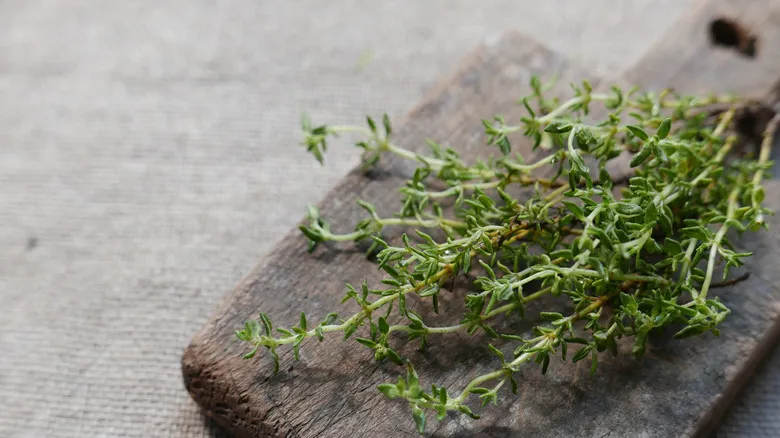
Gardeners who cultivate thyme at home, in their garden, or indoors may find themselves with an abundance. The same goes for those living near passionate gardeners, making it worthwhile to learn how to dry thyme. This way, you can enjoy flavorful dried herbs throughout the year.
Fortunately, drying thyme is a simple process: just hang it upside down for one to two weeks, then crumble the leaves and store them in a jar. Ensure that the drying area is warm, well-ventilated, and has low humidity. Ideally, the space should be somewhat dim, as bright light can speed up the oxidation process, which diminishes the herbs' aromatic qualities. If you don’t have a suitable spot to hang the herbs, you can also lay them flat on a tray to dry.
For those who are avid homesteaders with a large quantity of thyme to process, you might consider drying it in the oven at 100°F for 24 hours or using a dehydrator for one to two hours at the same temperature.
Storing thyme to last
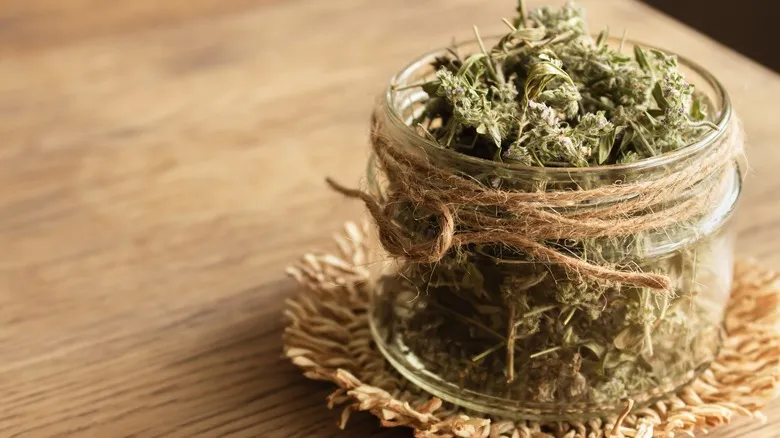
Thyme is quite resilient, but proper storage is essential for longevity. Fresh thyme can be kept in the refrigerator for one to two weeks if lightly wrapped in a plastic bag. Alternatively, you can freeze it in bags or blend it and pour the mixture into ice cube trays, then transfer the frozen cubes into a bag for storage. If you want to have your herbs ready for soups or sauces, you can also prepare them and freeze them in cubes with olive oil instead of water.
For dried thyme, the ideal storage method is in a glass container placed in a cupboard, away from light and heat. Ensure that the containers are airtight to prevent the essential oils that provide thyme's flavor and aroma from evaporating quickly. A good seal will also keep moisture out. When stored properly, thyme can maintain its flavor for up to two years.
Dried herbs won't spoil to the point of being harmful; they may simply lose their potency and flavor. Regardless of age, thyme is still usable as long as it retains a pleasant aroma. Conversely, even if it hasn't passed its expiration date, thyme can lose its effectiveness if it no longer emits that delightful herbal, earthy scent. This is where the seasoning sniff test comes into play; always take a moment to inhale the aroma before using dried herbs in your dishes.
Thyme health benefits

One of the most remarkable aspects of thyme is its impressive health benefits. It is rich in phytonutrients, which studies suggest may help guard against a variety of diseases. Thyme possesses anti-inflammatory and anticancer properties, and its capacity to combat free radicals can also shield against DNA damage that contributes to premature aging. As if that weren't sufficient, thyme is effective as an antiviral, antifungal, antibacterial, and antiseptic agent, and it can inhibit the formation of biofilms.
Additionally, using strongly flavored herbs like thyme allows you to enhance the taste of your dishes without relying heavily on salt, making it easier to prepare heart-healthy meals. Thyme essential oil, which contains 20-54% of the active compound thymol, can also be utilized for medicinal purposes.
However, it’s important to consult your healthcare provider before starting any medical regimen that includes essential oils or herbal supplements. Don’t assume that "plant-based" means "safe," particularly when it comes to children, pregnant women, the elderly, and individuals with health conditions.
Nutritional information
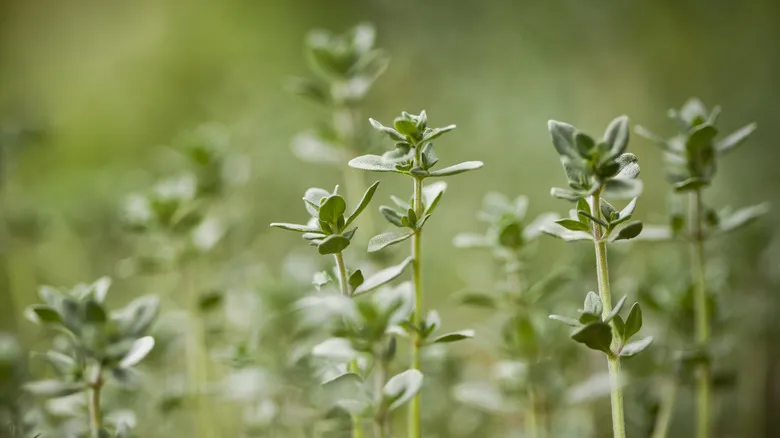
In addition to its health advantages, thyme boasts a strong nutritional profile while contributing negligibly to your calorie count. In fact, a teaspoon of thyme has less than a calorie, meaning it won't impact anyone's waistline anytime soon. It contains minimal amounts of water, protein, fat, fiber, and sugar.
However, thyme is rich in micronutrients, including calcium, magnesium, potassium, and more. Generously adding thyme and other fresh herbs to your meals can enhance your intake of these nutrients, which are vital for your body's proper functioning and support growth and development. These vitamins and minerals play crucial roles in various processes, such as enzyme production, hormone synthesis, maintaining mental clarity, and sustaining energy levels.
Fortunately, there are few risks associated with consuming thyme in moderation, unless you misuse essential oil or supplements. Both can pose dangers if taken in excessive amounts, so it's always wise to consult a healthcare professional.
Recommended

The Clever Hack You Need For Smash Burger-Inspired Tacos
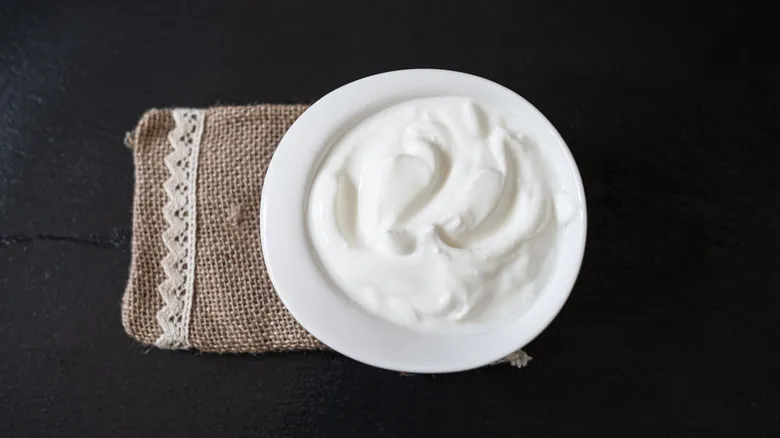
Transform Heavy Cream Into Sour Cream With One Easy Addition

The Clever Foil Hack To Make 2 Slow Cooker Dishes At Once

The Secret To Super Tender Oxtail According To Kwame Onwuachi
Next up

